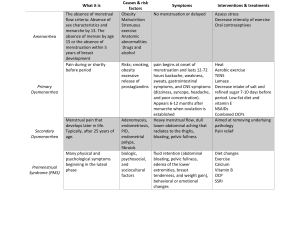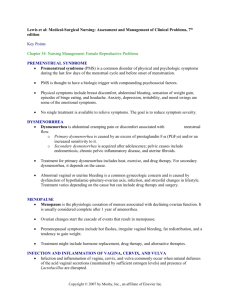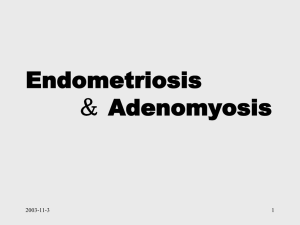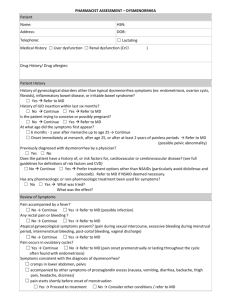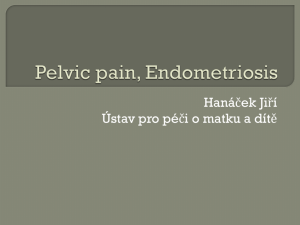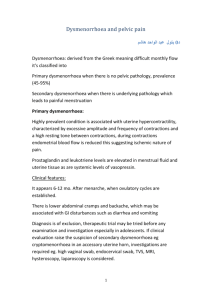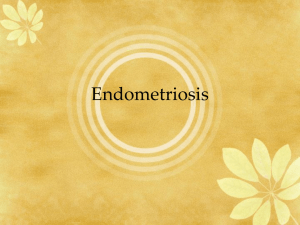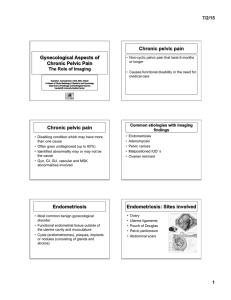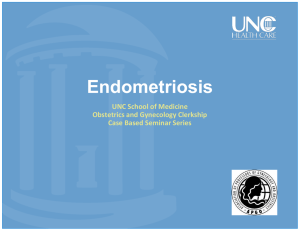dysmenorrhea & endometriosis
advertisement
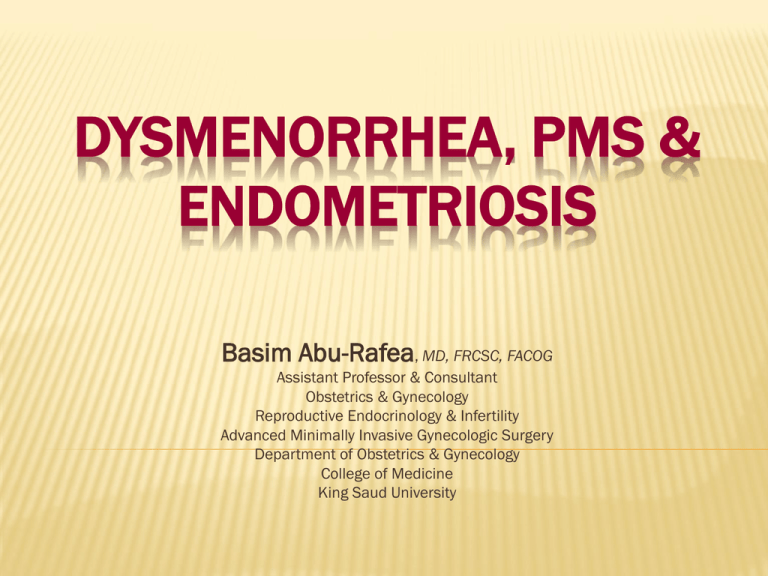
DYSMENORRHEA, PMS & ENDOMETRIOSIS Basim Abu-Rafea, MD, FRCSC, FACOG Assistant Professor & Consultant Obstetrics & Gynecology Reproductive Endocrinology & Infertility Advanced Minimally Invasive Gynecologic Surgery Department of Obstetrics & Gynecology College of Medicine King Saud University DYSMENORRHEA Introduction. Classification. Clinical features. Diagnosis. Management INTRODUCTION Painful menstrual period, characterized by cramping lower abdominal pain radiating to the back and legs, often accompanied by GI & neurological symptoms as well as general malaise. Affects approximately 50% of menstruating women, but about 5-10% have severe dysmenorrhea affecting daily activities. CLASSIFICATION I. Primary or idiopathic without pelvic pathology. II. Secondary underlying pelvic pathology. PRIMARY DYSMENORRHEA Usually appear within 1-2 yrs of menarche, when ovulatory cycles are established. Main physiological basis is increased endometrial prostaglandin productions. PRIMARY DYSMENORRHEA PGF2 alpha & PGE2 in high concentrations sp. in secretory endometrium because of decline of progesterone levels in late luteal phase. Increased uterine tone with high amplitude contractions reduced blood flow ischemic pain. CLINICAL FEATURES OF PRIMARY DYSMENORRHEA. Pain usually begins a few hours prior to or just after the onset of period & may last as long as 48-72 hrs. Labor-like pains with suprapubic cramping, lumbosacral backache radiating down the anterior thigh. CLINICAL FEATURES OF PRIMARY DYSMENORRHEA. Colicky pain improved with massage, counter pressure or movement. Nausea, vomiting, diarrhea with rarely syncope episodes. Normal findings except some tenderness. DIAGNOSIS Necessary to rule out underlying pelvic pathology. Confirm the cyclic nature of the pain. Consider differential diagnosis: Fibroid uterus Endometriosis Pregnancy complications like abortions & ectopic PID UTI Other causes of acute abdomen. TREATMENT Reassurance. Prostaglandin synthetase inhibitors are effective in approximately 80% of cases. Also improve menorrhagia if associated. NSAIDs-Mefenamic acid, Ibuprofen, Diclofenac etc may be taken with/ without antispasmodics. Drugs should be taken just prior to or at the onset of pain and continuously every 6-8 hrs to prevent reformation of PG by-products. TREATMENT Drugs should be taken for first few days of period for 3-6 cycles. Combined oral contraceptive pills is drug of choice in patients who fail to improve with NSAID ,or when NSAID contraindicated, or pt who desire contraception or associated with menorrhagia. TREATMENT OCP- suppress endometrial proliferation, inhibits ovulation no corpus luteum decrease prostaglandin synthesis. Should be taken from day 5day 21 for 3-6 cycles. In non-responders- codeine may be added. TREATMENT Usually relieved spontaneously after delivery.(sympathetic nerves at isthmus & cervix destroyed). Invasive procedures like D & C not desirable in nulliparous / unmarried. TREATMENT Transcutaneous electrical nerve stimulation, paracervical block etc. may be useful. Laparoscopic uterine nerve ablation or presacral neurectomy –used rarely in severe & non-responding cases. SECONDARY DYSMENORRHEA. Usually occurs many years after the onset of menarche. Pain often begins 3-5 days prior to period & relieved with onset of period, but sometimes may persist continuously up to a few days after the cessation of bleeding. UNDERLYING PATHOLOGY IN SECONDARY DYSMENORRHEA. 1. 2. 3. 4. 5. 6. 7. Endometriosis / Adenomyosis. Fibroid uterus Congenital uterine anomalies- bicornuate, septate etc. Cervical stenosis. Endometrial polyps. Pelvic inflammatory disease. IUCD DIAGNOSIS Abdominal & vaginal examination may reveal the underlying lesion. May need investigations like US, laparoscopy, hysteroscopy, hysterosalpingogram etc. TREATMENT Analgesics. Treatment of underlying cause accordingly. PREMENSTRUAL SYNDROME PMS Is a group of physical, emotional & behavioral symptoms that occur in the 2nd half (luteal phase) of the menstrual cycle Often interfere with work & personal relationships followed by a period entirely free of symptoms starting with menstruation INCIDENCE 40% Significantly affected at one time or another. 2-3% Severe symptoms with impact on their work & lifestyle 5% by the American psychiatric association definition PHYSICAL SYMPTOMS Bloating Weight gain Breast pain & tenderness Skin disorders “acne” Hot flushes Headache Pelvic pain Changes in bowel habits Joint or muscle pain edema EMOTIONAL / PSYCHOLOGICAL SYMPTOMS Irritability Aggression Tension Anxiety Depression / interest in the usual activities Lethargy Sleep disturbances Change in appetite overeating or food craving Crying Change in libido Thirst Loss of concentration Poor coordination, Clumsiness, accidents ETIOLOGY Unknown cause. Many theories have been postulated, most of them have todo with various hormonal alterations. Vitamin B6 deficiency Multi-factorial psycho-endocrine disorder Ovulation / progesterone production are important in this syndrome Drugs that inhibit ovulation relief of PMS symptoms EVALUATION Pt should keep a diary of her symptoms throughout 2-3 menstrual cycles. Complete History & physical examination to R/O any medical problem DIAGNOSIS The Diagnostic Statistical Manual for Mental Disorders requires 5 of the following: Depressed mode Anxiety Emotional Liability Irritability Change in appetite Lethargy Sleep disturbance Out of control Lack of interest Physical symptoms Occur in the week before menses in most menstrual cycles Disappear few days after the onset of menses Impair social, occupational function or the ability to interact with others. TREATMENT 1- SUPPORTIVE 2-MEDICATIONS: The selection of medications should be tailored to the patient’s main symptoms. ENDOMETRIOSIS ENDOMETRIOSIS Definition: Ectopic Endometrial Tissue True Incidence Unknown: ? 1-5% 30 -40 % Infertility patients Does NOT Discriminate by Race Histology: Endometrial Glands with Stroma +/Inflammatory Reaction SIGNS AND SYMPTOMS Chronic Pelvic Pain, Dysmenorrhea Infertility Deep Dyspareunia Pelvic Mass (Endometrioma) Misc: Tenesmus, Hematuria, Hemoptysis AGE AT DIAGNOSIS 36 –45 15% > 45 3% < 19 6% 19 – 25 24% 26 –35 52% ETIOLOGY: THEORIES Sampson: “Retrograde Menstruation” Hematologic Spread Lymphatic Spread Coelomic Metaplasia Genetic Factors Immune Factors Combination of the Above No Single Theory Explains All Cases of Endometriosis DIAGNOSIS Laparoscopy (“Gold Standard) Laparotomy Inconclusive: CA-125, Pelvic Exam, History, Imaging Studies Biopsy Preferable Over Visual Inspection APPEARANCE Endometriosis May Appear Brown Black (“Powder burn”) Clear (“Atypical”) APPEARANCE APPEARANCE APPEARANCE APPEARANCE CLASSIFICATION / STAGING Several Proposed Schemes Revised AFS System: Most Often Used Ranges from Stage I (Minimal) to Stage IV (Severe) Staging Involves Location and Depth of Disease, Extent of Adhesions CLASSIFICATION / STAGING TREATMENT: OVERALL APPROACH Recognize Goals: – Pain Management – Preservation / Restoration of Fertility Discuss with Patient: – Disease may be Chronic and Not Curable – Optimal Treatment Unproven or Nonexistent PAIN MANAGEMENT: MEDICAL THERAPY NSAIDs OCPs (Continuous) Progestins Danazol GnRH-a GnRH-a + Add-Back Therapy Misc: Opoids, TCAs, SSRIs CONTINUOUS OCP’S “Pseudopregnancy” (Kistner) ? Minimizes Retrograde Menstruation Choose OCP’s with Least Estrogenic Effects, Maximal Progestin Effects PROGESTINS May be as Effective as GnRH-a for Pain Control MPA 10-30 mg/day, DP 150 mg Semi-Monthly Relatively Inexpensive Side-Effects: AUB, Mood Swings, Weight Gain, Amenorrhea DANAZOL Weak Androgen Suppresses LH / FSH Causes Endometrial Regression, Atrophy Expensive Side-Effects: Weight Gain, Masculinization, Occ. Permanent Vocal Changes GNRH-A Initially Stimulate FSH / LH Release Down-Regulates GnRH Receptors– ”Pseudomenopause” Long-Term Success Varies Expensive Use Limited by Hypoestrogenic Effects May be Combined with Add-Back SURGICAL TREATMENT (LAPAROSCOPY / LAPAROTOMY) Excision / Fulguration Resection of Endometrioma Lysis of Adhesions, Cul-de-sac Reconstruction Uterosacral Nerve Ablation Presacral Neurectomy Appendectomy Hysterectomy +/- BSO
